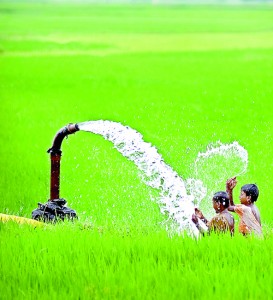Sunday Times 2
What water’s worth
SINGAPORE/ATLANTA – In the early nineteenth century, Lord Byron wrote in Don Juan that “Till taught by pain, men really know not what good water’s worth.”
Nearly 200 years later, humanity still does not seem to understand water’s value, exemplified in decades of poor water management and governance practically everywhere. But the impending water crisis is becoming increasingly difficult to ignore — especially for those who are already feeling its effects.

In the last decade alone in India, tube-wells have moved from 10-15 metres to 200-400 metres deep. Pic courtesy http://www.janakalyansamity.org
To be sure, some improvements in water management have been made in recent years. But they have come incrementally, at far too slow a pace to address the problem effectively.
To help kick-start progress, major multinational companies like Nestlé, Coca-Cola, SABMiller, and Unilever — which have long emphasised to their investors the challenge that water scarcity poses for their businesses, not to mention the communities in which they operate — are working to improve water availability, quality, and sustainability. Their success will require an innovative strategy that upends entrenched assumptions about — and approaches to — water-related problems.
For example, the prevailing view that the world needs good water management, though accurate, is too narrow. Water management should not be regarded as an end in itself — a single-variant solution for a single-variant problem — but as a means to several ends, including environmental conservation and social and economic development.
Viewed in this broader context, many of the paradigms, practices, and processes that are currently being used to manage communities’ water resources must change. Given that competition for water resources cannot be disentangled from competition for, say, food and energy, it cannot be addressed independently. Multivariant problems demand multivariant solutions.
Complicating matters further, these problems’ backdrop is likely to change considerably over the next few decades, owing to demographic shifts, population growth, urbanisation, migration within and among countries, globalisation, trade liberalisation, and rapid expansion of middle classes in the developing world. These shifts will accompany rapid industrialisation and advances in science and technology (especially information and communications technology), and will transform dietary habits and consumption patterns.
As a result, water-consumption patterns will change considerably, including indirectly, through shifts in agriculture, energy, and land use. Indeed, these linkages are already evident in many parts of the world. For example, in many Asian countries — including India, China, and Pakistan – groundwater levels are declining at an alarming rate, owing to over-extraction and energy subsidies.
For India, the problem began in the 1970s, when major donors encouraged the government to provide farmers with free electricity for irrigation. The subsidies were manageable at first, and achieved their goal of boosting food production in states like Punjab, Haryana, Rajasthan, Gujarat, and Maharashtra.
But the policy removed the incentive for farmers to limit the amount of water they pumped. They had to invest only in installing the actual pumps — and they did so willingly, resulting in a total of 23 million water pumps today.
This profligacy has taken a serious toll on groundwater levels, forcing the tube-wells from which the water is pumped to be installed ever more deeply. According to the Third World Centre for Water Management, the amount of electricity required to pump water in India has doubled — and, in some cases, even tripled — in the last decade alone, as tube-wells have moved from 10-15 metres (32-50 feet) to 200-400 metres (650-1300 feet) deep. The increasing depth requires 3-4 times more horsepower for each pump.
Under these conditions, state water ministries have few options for making groundwater irrigation sustainable. With the relentless increase in electricity subsidies, which are squeezing the energy sector, it is difficult to devise effective policies to stem over-pumping.
The water sector will have to react to developments in the energy and other sectors, over which, despite close ties, it has very limited control. Coordinating the various sectors’ policies effectively will be difficult, to say the least.
It may sound daunting, but the reality is that these challenges are surmountable – if, that is, our leaders commit to tackling them. We already have the needed technology, know-how, experience, and even financing. With strong political will, sustained pressure from an informed public, and a “can do” attitude from water professionals and institutions pursuing intersectoral cooperation, the world’s water-management problems can be addressed effectively.
But we must act now. Time — and water — is running out.
(Asit K. Biswas is Distinguished Visiting Professor at the Lee Kuan Yew School of Public Policy in Singapore, and the co-founder of the Third World Centre for Water Management. Ahmet C. Bozer is Executive Vice-President of the Coca-Cola Company and President of Coca-Cola International.)
Copyright: Project Syndicate, 2014. Exclusive to the Sunday Times
www.project-syndicate.org

